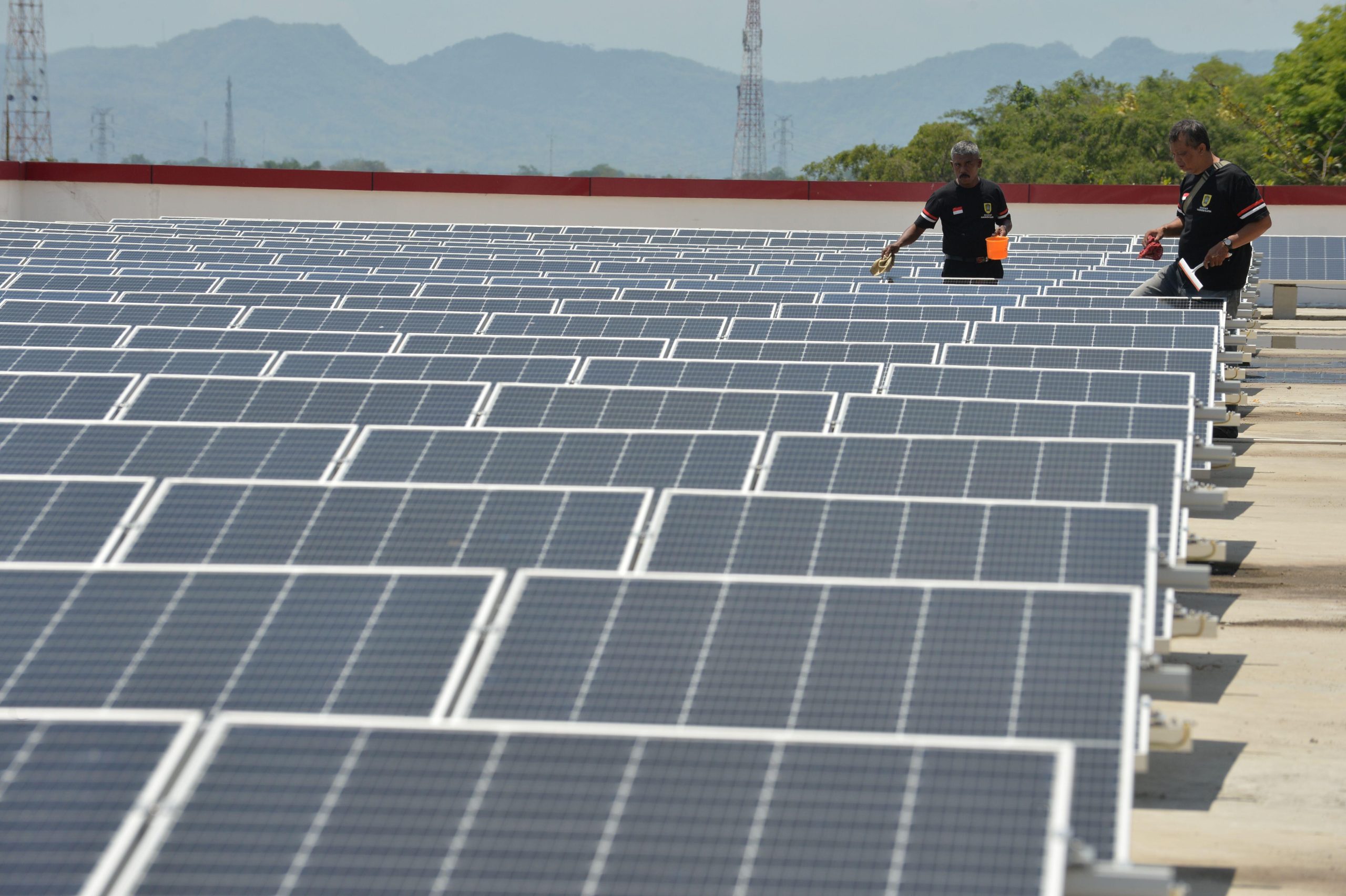
Indonesia’s expansion of clean power can spur growth and equality
Raising renewables ambition and fair allocation of renewable energy projects can remediate emissions from fossils and help make transition more equitable.
Available in: Bahasa Indonesia
Table of Contents
Highlights
Executive summary
Indonesia’s clean power capacity needs to grow rapidly to end fossil fuel dependence
Raising renewable ambitions will ensure no new coal additions are needed to meet Indonesia’s growing electricity demand by 2030, supporting energy transition in coal producing provinces.
It has been 10 years since Indonesia introduced the National Energy Policy (NEP) in 2014, addressing supply and demand management, including conservation, diversification and efficiency. This year, the government is set to launch a new NEP expanding measures to improve energy security and promote energy transition with aims to peak emissions by 2035 and achieve net zero by 2060. Unfortunately, the renewable energy target is expected to be reduced from 23% to between 17-19% by 2025.
The latest data from 2023 shows that fossil fuels account for 81% of Indonesia’s electricity, representing the largest share of its electricity generation. The use of fossil fuels, particularly coal, has risen significantly in the past ten years, resulting in a sharp increase in power sector emissions, rising by 86 million tonnes of CO2 (MtCO2) from 2013 level to 2023 level.
Under the RUPTL, 21 GW of renewable energy capacity will be added between 2021 and 2030. Meeting the JETP targets will require 36 GW more renewable capacity, playing an important role in employment creation and growth in the local economy.
Allocating renewables project construction to coal producing regions would deliver substantial benefits for governments, industry and citizens, making Indonesia more equitable in cushioning the impact of energy transition. Under existing programmes which include 2.7 GW renewable energy projects in East Kalimantan, South Kalimantan and South Sumatra, Ember estimates this would create 50,000 jobs and attract $4.3 billion USD in investment. Further developing 5.8 GW solar projects and cancelling new coal capacities could create additional 46,000 jobs and more than double the investment on renewable energy projects.
Key takeaways
Indonesia’s electricity generation from fossil fuels has increased by 50% in the past decade
Electricity generation from fossil fuels has increased from 190 TWh in 2013 to 285 TWh in 2023, mainly driven by coal’s prominent role in Indonesia’s energy strategy and coal capacity buildup under the electricity infrastructure development plan. During the same period, renewables generation increased from 36 TWh to 65 TWh.
Improving coal power plants efficiency can avoid 42 TWh of unnecessary coal generation
Based on the RUPTL, it is likely that Indonesia on-grid electricity demand increases by about 4.7% annually, reaching 445 TWh by 2030. With the improvement of coal power plants capacity factors from 49% in 2023 to 64% by 2030, generation will likely surpass demand by 42 TWh. This suggests Indonesia should reconsider building new power plants to avoid high risk of stranded assets.
Renewable energy programmes could help transform the economies of coal producing regions
Coal producing regions, including East Kalimantan, South Kalimantan and South Sumatra emit around 30 million tonnes of CO2 equivalent (MtCO2e) from coal mining methane and coal-fired power plants. These regions also face job loss risks due to mine closure. Tapping into the existing 2.7 GW of renewable energy project pipelines and expanding 5.8 GW solar projects could help these regions reduce emissions, attract more than $9.4 billion USD investment and create 96,000 high-skilled jobs.
Starting point
Indonesia’s energy landscape after a decade shows a significant increase in coal use
Coal use in the electricity sector in the past ten years has nearly doubled, contributing to a sharp rise in overall power sector emissions, totalling 86 million tonnes of CO2 (MtCO2) from 2013 to 2023, mainly from coal.
Indonesia has not yet seen a boom in renewables, resulting in fossil fuels meeting its electricity demand growth. The National Energy Policy (NEP) 2014 set a target of 23% of renewables in the energy mix by 2025, however, this target is likely to be reduced to between 17-19% in the revised NEP currently being developed.
In reality, the growth of renewable capacity has been slow. Between 2018 and 2023, Indonesia only added 3.3 GW of renewables, bringing the total to 13 GW by 2023.
The largest capacity additions were in bioenergy (+1.3 GW), followed by hydropower (+1 GW), solar (+0.5 GW), geothermal (+0.5 GW) and wind (+0.01 GW). In contrast, the county installed an additional 26 GW of fossil fuel capacity in the last five years. Fossil fuels now account for 80 GW, or 86% of the total power generation capacity of 93 GW in 2023.
In 2023, renewables accounted for 19% (65 TWh) of Indonesia’s electricity mix, including both on-grid and off-grid sources. Solar and wind generation only contributed 0.2% (0.7 TWh) and 0.1% (0.5 TWh), respectively. Hydro was the largest contributor at 7% (25 TWh), followed by bioenergy at 6.4% (22 TWh) and geothermal at 4.8% (17 TWh).
The remaining 81% (285 TWh) of electricity demand was met by fossil fuels. In 2023, coal contributed 62% (217 TWh) of electricity generation. Electricity from gas also recorded a 6.9% rise from 58 TWh in 2013 to 62 TWh in 2023.
The sharp rise in power sector emissions in the past decade has been attributed to the record installations and utilisations of carbon-intensive electricity generation capacity, particularly coal (+30 GW), gas (+6 GW) and biomass (+1.5 GW). This surge has been driven by investment in coal power plants, spurred by the government’s 35,000 MW electricity construction programme introduced in 2015 that considerably sped up the pace of new power plant construction under the auspices of 5-7% economic growth.
Loans for capital spending on coal power plants reached $1 billion USD in 2021-2022, leading to overcapacity in coal-fired generation.
The “greenest” electricity supply plan
Under the NEP, a National Energy General Plan (RUEN) provides a detailed strategy for cross-sectoral implementation to meet NEP targets. For the power sector, the National Electricity Master Plan (RUKN) provides the regulatory framework to guide the state utility (PLN) in developing its Electricity Supply Business Plan (RUPTL).
The RUKN includes four pathways to meet Indonesia’s climate targets: Business-as-Usual, IEA net zero emissions scenario, zero-emissions retrofitting and zero-emissions CCS. The choice of pathway depends on the pursued targets (least cost or zero emissions), assumptions about CO2 removal and technological use.
The RUKN serves as the basis for PLN’s ten-year electricity plan (RUPTL). The latest version, RUPTL 2021-2030, outlines the plan for capacity additions for different energy sources, with renewables accounting for 52% (+21 GW) of overall additions by 2030, and the rest from fossil fuels (+20GW). If RUPTL targets are met, renewables capacity will be around 31 GW, or a 31% share of the total installed capacity of 102 GW in 2030.
When first introduced, RUPTL 2021-2030 was considered as the greenest electricity supply plan to achieve carbon neutrality by 2060. Compared to the previous RUPTL 2019-2028 that aimed to build 16.7 GW of renewables, the latest plan aims to build 20.9 GW of renewable energy capacity, or 51.6% of the total build plan of 40.6 GW.
The upcoming RUPTL for the year 2024-2033 will include an Accelerated Renewable Energy Development (ARED) scenario. In this scenario, the electricity system will be composed of 75% renewable energy (61 GW) and 25% gas (20 GW).
To accommodate the intermittent characteristics of variable renewable energy (solar and wind), PLN will build an end-to-end smart grid infrastructure and flexible generation to enable large scale solar and wind penetration. Gas power plants will be used to compensate for the load changes and fluctuations resulting from high variable renewable energy penetration. In addition, PLN will also build an inter-island connection to evacuate the scattered potential of renewable energy sources that are mostly located in Sumatera, Kalimantan, Sulawesi and Nusa Tenggara Islands, and direct them towards the demand centre in Java Island.
Improving coal power plants efficiency can avoid unnecessary generation of coal
The Ministry of Energy and Mineral Resources, in its draft RUKN 2023-2060, forecasts Indonesia’s electricity demand growth rate to be between 4.8% and 5.2% annually. This will result in power demand increasing from 363-377 TWh in 2023 to 1,846-2,152 TWh in 2060.
Due to the disruption caused by the COVID-19 pandemic, Indonesia’s electricity demand growth rate has slowed in recent years, causing an overcapacity in the Java-Bali system of around 6 GW in 2023. In 2023, electricity demand grew modestly by 3.4% to 346 TWh, below the proposed NEMP scenario of about 3.9% – 5.2% annual growth from 2022 to 2060.
Meanwhile, Indonesia’s coal power capacity more than doubled from 25 GW to 52 GW between 2015 and 2023, following the introduction of the 35,000 MW programme. During the same period, capacity utilisation fell by 8%, reaching 48% in 2023, indicating that some coal-fired power plants might not be operating at full capacity.
Using an optimistic electricity demand growth scenario based on PLN’s RUPTL 2021-2030, Ember’s calculation shows that annual on-grid electricity demand will grow by 4.7% between 2023 and 2030, reaching 445 TWh in 2030, up from 323 TWh in 2023. This is similar to what PLN forecasts, a 4.9% rise in electricity demand between 2021 and 2030, driven by a rebound from the pandemic recovery.
Currently coal power plants are running at around 49% capacity factor, much lower than the suggested capacity factor for coal power plants in the RUPTL in 2030 between 64-73%. Raising the coal power plants efficiency using 64% capacity factor in the benchmark suggests production will surpass demand. The excessive electricity generation from coal will be 42 TWh by 2030, if the coal targets in the RUPTL are met. This suggests new coal plants have high stranded assets risk and hence should not be considered.
The avoided cost from coal-generated electricity, which could be allocated to renewables, is between $1.9 billion USD and $2.4 billion USD, based on the levelised cost of energy calculation for coal power plants operating at 64% capacity factor.
This presents opportunities to grow clean power and avoid unnecessary coal investment, even with rising demand.
Maintaining JETP Momentum
Raising renewables ambitions will improve future energy security
The Just Energy Transition Partnership targets raising the renewables share to 44% by 2030 and further to 66% by 2035.
The aspiration to improve electricity system security, adequacy and sustainability has led to Indonesia’s participation in the Just Energy Transition Partnerships (JETP). Under the JETP scenario, renewable energy share in the power mix will reach 44% by 2030, with solar and wind accounting for 8% and 6% of total electricity generation, respectively. This marks a significant increase for both energy sources from less than 1% today.
Although the JETP mechanism represents an ambitious step forward, further refinements are needed. Key areas of improvement include implementing more solar and wind power, conducting a more rigorous evaluation to ensure bioenergy’s role is both practical and sustainable, and adopting a more ambitious coal retirement plan in line with Indonesia’s 5.2 GW retirement target by 2030.
Given Indonesia’s changing electricity demand profile, driven by population growth, electrification in the transportation sector and increasing demand from the manufacturing sector, there are concerns about whether renewable power growth will accelerate fast enough to meet the surge in demand.
How would a 44% JETP target align with Indonesia’s electricity supply plan?
Achieving the emission reduction target set in the JETP requires the right amount of financing and appropriate financial mechanism, as well as formulating a comprehensive road map for the development of the solar panel industry to attract more investors. To meet this target, Indonesia would need to build an additional 8.9 GW of solar and 2.9 GW of wind every year, beyond the target set in RUPTL. This would result in an installed solar and wind capacity of about 38 GW by 2030.
The JETP scenario also relies on storage solutions to absorb surplus energy and discharge it during peak evening demand. Considering the expansion of industrial parks and nickel smelters in Sulawesi, there will be more opportunities to capture the captive market with renewables potentials.
Moving forward with this scenario underpins the urgent need to improve current grid infrastructure and overall system flexibility to accommodate more solar and wind. According to JETP’s Comprehensive Investment and Policy Plan (CIPP) 2023 document, the grid should be upgraded to increase the absorption of solar and wind from 14% in 2030 to 36% by 2050, including captive connections. Increasing the flexibility of coal power plants is also important to cope with increasing solar absorption in the future.
The CIPP identifies solar as having the greatest potential for development. This depends on how well potential rooftop PV adopters respond to the new Minister of Energy and Mineral Resources Regulation Number 2 of 2024, which addresses rooftop solar power plants. Another important factor would be how well PLN can accelerate its transmission grid connection and smart grid to accommodate higher solar penetration and address solar energy intermittency to manage system security. The Regulation introduces a new solar quota for both on-grid and off-grid networks, aiming to increase solar energy use among households, commercial and industrial customers. Another potential is to reallocate the JETP fund to incentivise potential solar adopters.
Renewables push can make energy transition more equitable
Major coal producing provinces are at the forefront of energy transition. They will already have existing electricity and transportation infrastructure that could help developers reduce capital costs in solar PV deployment. Around 2,300 square kilometres of licensed mining area in Indonesia is disturbed land, which could host around 0.5 TW of solar PV capacity.
These provinces are laboratories for fossil fuels phase-out, and shape how “just” and inclusive the transition will be. Economic growth incentives will be crucial for these provinces to fully engage with climate change challenges.
What measures are needed? Allocating more renewable projects in these provinces is the starting point, by considering the compatibility location of these provinces for renewable deployment. Opening new industries will generate capital gains, create new jobs and increase tax revenues for provincial governments. In terms of just transition, these provinces will foster local energy resiliency and support sustainability actions. Thus, pushing for renewables can simultaneously drive economic growth and advance just transition goals.
Analysis of local coal production in Indonesia reveals that the three largest coal producing regions in 2022 are East Kalimantan, South Kalimantan and South Sumatra. However, the JETP’s CIPP document indicates that most renewable project investments are primarily concentrated in Java instead.
Moreover, the allocation of JETP’s priority projects in the CIPP document only covers 43% (23.86 GW) of the total additional renewable energy capacity needed between 2020 and 2030 (54.5 GW). This suggests that achieving the JETP target may face headwinds due to unclear project planning and insufficient financing commitments.
Transition in coal producing regions
The heart of the deal
Indonesia’s coal producing regions may be impacted by the energy transition. However, various renewable energy programmes present opportunities to transform these coal-based economies by attracting clean technology investments and creating high-skilled job opportunities.
As a coal-rich nation, Indonesia’s economy is closely tied to coal, particularly for export markets and domestic industries.In terms of exports, the country has seen a steady increase in coal exports, rising from 356 million tonnes in 2018 to 518 million tonnes in 2023, with export values ranging from $14 billion USD to $46 billion USD.
However, the value of these exports declined by 26% from 2022 to 2023 driven by declining commodity prices. India, as the second biggest importer of Indonesian coal, also shows reduced interest in continuing its reliance on coal imports. Despite the global trends in shifting away from coal, the Indonesian government still has set an ambitious target to boost coal production to over 900 million tonnes in 2024.
At the same time, local leaders in coal rich provinces are concerned about ensuring continued fossil fuel investment. China, the largest investor in Indonesia’s coal power plants, has announced it will stop building new coal power projects overseas. This decision could limit funding for Indonesia and cast doubts on the future of coal power projects.
Maintaining high coal production levels will increase the risk of stranded assets and worsen the environmental impacts of coal mining, which continue to affect much of Indonesia, particularly in coal producing provinces.
East Kalimantan, South Kalimantan and South Sumatra are major coal producing regions in Indonesia. In 2022, they each contributed around 302 million tonnes, 204 million tonnes and 88 million tons of coal, respectively, accounting for over 85% of Indonesia’s total coal production.
Economic activities in these provinces are highly dependent on the coal sector. In East Kalimantan and South Kalimantan, coal contributes more than 44% and 30% of gross regional domestic product (GRDP), respectively. Nationwide, the sector also supports more than 150,000 jobs. As the energy transition progresses, a decline in the coal sector is expected to significantly impact the economies of these provinces.
Unfortunately, discussions on just transition in these coal producing regions have not yet been incorporated into the JETP recommendations.
What does energy transition mean for coal producing regions?
The coal sector poses a risk of job losses due to the end of mine lifecycles. East Kalimantan, for example, is among the top 10 most impacted provinces, with an estimated 17,000 coal mining jobs likely to be lost by 2050. Nationally, the peak of coal miner layoffs is predicted to occur around the 2030s.
With the global energy transition trend, major coal producing regions will face increased risks due to declining coal demand. The Indonesian Ministry of Energy and Mineral Resources (MEMR) predicted that domestic coal production could drop to 250 million tonnes in 2060. This drop in coal consumption will impact local employment, regional GDP contribution and economic activities in these regions.
The economy of East Kalimantan, for example, is heavily reliant on the extractive sector. When coal prices skyrocketed in 2022 to an average price of around $345 USD/ton, royalty fees from the mining sector amounted to IDR 4.6 trillion (approximately $285 million USD), almost 40% of the province’s revenue. In addition, the sector has created more than 130,000 jobs. However, if the mining and oil and gas sectors were to be completely depleted, the economy of East Kalimantan could decline by 65%.
Following the latest sustainable taxonomy, investors and financial institutions are increasingly aware of environmental, social and governance (ESG) issues and start assessing the risks associated with investing in the coal sector. Major coal companies in Indonesia, such as Indika Energy and Adaro Energy, have begun to diversify into clean energy and committed to reducing their revenue from thermal coal. These corporate shifts will likely impact the coal sector in the regions, as financial resources are reallocated to other sectors and potentially other locations.
Emission risks from coal includes overlooked coal mine methane emissions
Dependence on the coal sector also results in substantial environmental impacts in coal mining regions. It is estimated that 143,592 hectares of natural forest in Kalimantan have been deforested and converted into coal mines. In addition, coal mining activities and coal power generation also significantly contribute to energy sector emissions.
With total coal production of around 600 million tonnes, these three provinces release a significant amount of methane emissions from coal mining activities, commonly referred as coal mine methane (CMM). In 2022, CMM emissions are estimated at 516 kilotonnes of CH4. Given that CMM has a long-term climate impact 30 times greater than carbon dioxide, this translates to approximately 15.4 million tonnes of CO2e. Unfortunately, CMM emissions are not included in the subnational greenhouse gas inventories and mitigation plans for these provinces.
In addition to generating methane emissions from coal mining, these provinces rely heavily on coal for electricity. In 2022, East Kalimantan and South Kalimantan hosted coal-fired power plants (CFPPs) with total capacities of 987 MW and 571 MW, respectively. Meanwhile, South Sumatra had 1,340 MW of CFPPs, which supplied electricity for the province and neighbouring areas. Altogether, these CFPPs are estimated to emit more than 15 million tonnes of CO2e annually, matching the level of CMM emissions.
Within RUPTL 2021-2030, PLN also plans substantial additions to CFPPs in these provinces. South Sumatra will see an increase of 2,100 MW, while South Kalimantan and East Kalimantan will add 214 MW and 14 MW, respectively. These expansions are expected to raise both emissions from CFPPs and coal mine methane by more than 12.6 million tonnes CO2e. Furthermore, this could heighten stranded asset risks and hinder efforts to reduce emissions and diversify the economy.
Renewables present various benefits for coal regions
Despite potential impacts on the coal sector, energy transition offers long-term economic transformation opportunities for coal producing regions. Renewable energy projects and clean energy manufacturing present promising alternatives. For example, Inner Mongolia is accelerating its new-energy industry plan, aiming to generate clean electricity and establish itself as a leading hub for clean technology manufacturing.
In Indonesia, both PLN and the government have initiated several renewable energy programmes that cover coal producing regions with a total potential of 2.7 GW. PLN’s RUPTL, claimed to be the “greenest” business plan, includes a total of 1.6 GW of renewable energy projects across these three provinces. Furthermore, 391 MW of diesel generators could be replaced with renewable energy through PLN’s diesel substitution programme. The newly launched PV rooftop regulation also offers opportunities for building owners to reduce their emission footprints and electricity bills, with potential of 536 MW until 2028. Building owners and homeowners can process easy and fast installation of rooftop solar PV systems, which makes it suitable to become a choice for transition.
In addition to these existing programmes, coal producing regions could gain greater benefits by replacing additional coal capacities with solar. A total of 2,328 MW of CFPP that will be built between 2021 and 2030 could be replaced with 5.8 GW of solar across these three provinces. The addition of solar capacity is aligned with the CIPP scenario and could be part of priority projects within CIPP.
These programmes will trigger a multiplier effect in these coal regions. The total investment required for these projects could reach an estimated amount of $9.4 billion USD. The projects are also expected to create around 95,000 high-skilled jobs, which could offset the job losses from mine closures. Investment opportunities in clean technology manufacturing, such as solar modules and other components, could further boost both investment and job creation.
Furthermore, implementing these programs will reduce energy sector emissions in these three provinces. Renewable electricity generation could avoid 18 million tonnes of CO2 equivalent emissions from fossil fuel power plants and keep 12 million tonnes of coal beneath the surface.
This could also lay the groundwork for investment in clean technology manufacturing in these regions.
Takeaways
Indonesia’s energy policy beyond 2024
Under Indonesia’s new presidency, affordability and accessibility will likely remain at the heart of transition.
This year, Indonesia will submit its 2035 targets to the UN, along with updated targets for 2030. The Enhanced Nationally Determined Contribution (E-NDC) will increase the emissions reduction target in the energy sector to 358 million tonnes by 2030, with renewables development a big part of the plan.
Indonesia’s energy sector target to achieve carbon neutrality by 2060 is stipulated in the National Energy Policy (NEP), last updated ten years ago in 2014. The revised NEP, expected to be released this year, will reduce the renewable energy target from 23% by 2025 to between 17-19% in the energy mix.
As a result, Indonesia’s climate commitments in the energy sector may progress slower than previously anticipated. However, the longer the country remains dependent on fossil fuels, the more difficult it will be for its leaders to meet the net-zero ambitions.
Uniting energy transition, climate and development goals
Evidence suggests that Indonesia’s energy transition should be well under way. The government has set a target to support renewable energy development in the New Energy and Renewable Energy Bill through increasing on-grid renewable capacity, converting diesel power generation to solar and expanding rooftop solar. The new bill should clearly define the proportion of renewable energy generation in the total electricity mix, instead of the percentage of ‘new’ energy sources, such as nuclear and fuels derived from fossils.
Even though fossil fuels will continue to play a significant role, the demand for them will not peak and decline until 2030 under the JETP scenario. This timeline provides the government with the opportunity to adjust its power sector development plan and gives coal producing provinces time to develop new strategies. Both national and local governments will need to shape policies that support clean energy transition. Ultimately, a successful transition will depend on effective governance at various levels in Indonesia.
Given Indonesia’s multilevel and multi-sectoral governance structure, establishing a long-term sustainability goal that integrates energy transition, climate and development ambitions can align just transition with high-quality economic growth. This inextricably distributes the tasks of transition more dynamically across a wider spectrum of government actors. Indonesia stands a better chance of successfully driving its clean power growth, if these actors collaborate effectively.
As a coal producing country, Indonesia may have some advantage in shielding its population from sporadic price shocks that threaten energy affordability. While PLN and the government may continue the subsidy mechanism to keep energy services affordable, access to electricity remains a big challenge in the rural areas. Inevitably in the long run, shocks may arise from the depletion of finite resources.
Increased international and regional cooperation in energy transition will also provide incentives to help developing countries with their energy transition plans, under the principle of Common But Differentiated Responsibilities (CBDR). CBDR acknowledges that responsibility is unequally distributed due to historical contributions to climate change and economic capacities.
Renewables can improve energy access in rural areas. For Indonesia, where affordability and accessibility are top government priorities, well designed policies supporting renewable energy will be essential to buffer the shocks.
Supporting materials
Acknowledgements
Cover photo
Workers cleaning and checking solar panels installed on the balcony of the Gedhe market in Klaten, Central Java, Indonesia.
Credit: ZUMA Press, Inc. / Alamy Stock Photo
Contributors
Our sincere gratitude to Mada Ayu Habsari, Edo Mahendra and David Silalahi for their invaluable support in peer reviewing this report.
Special thanks to Rini Sucahyo for her unwavering support through editing and structuring the report, Aditya Lolla for his valuable comments and insights, Neshwin Rodrigues for discussions on data assumptions and validity. A heartfelt gratitude to Libby Copsey, Oya Zaimoglu and Chelsea Bruce-Lockhart, for their support in data validation and visualisation.
Methodology
Generation, imports and demand
Annual data from 2000 to 2023 is taken from the Handbook of Energy and Economic Statistics of Indonesia 2023.
The 4.7% annual rise in electricity demand between 2023 and 2030 is calculated based on the historical demand data from 2023 and projected demand in 2030 as stipulated in the RUPTL 2021-2030.
Ember analyses
In Chapter 1, we calculate renewable energy generation by 2030, using coal capacity data in 2023 and RUPTL targets. The analysis is based on annual growth rates for electricity demand at 4.7%, and capacity factors for coal at 64%, solar at 20%, hydro at 52% based on the average capacity factor of hydropower across all types of plants in 2022 and wind at 35%.
The range for electricity cost generation from coal is calculated using PLN’s average generation cost for coal technology in 2023 (Rp. 737.52 per kilowatt hour) and a levelized cost of electricity in which the methodology is taken from NREL Annual Technology Baseline 2023.
Chapter 2 assessment compares capacity addition plans in the RUPTL 2021-2030 and JETP’s CIPP document.
In Chapter 3, we calculate emissions from coal power plants and coal mine methane. Emission factors are collected from the cap and trade regulation for CFPP and IPCC’s average emission factor for surface coal mines.
Renewable energy generations are estimated using capacity factors from the power sector’s technology catalogue. Job creation opportunities are calculated based on the number of jobs per Gigawatt hour of renewable energy generation.Investment opportunities are calculated based on IRENA’s average cost of electricity for renewables. Emission avoidance from new RE projects are calculated using PLN’s grid emission factors.
Related Content







